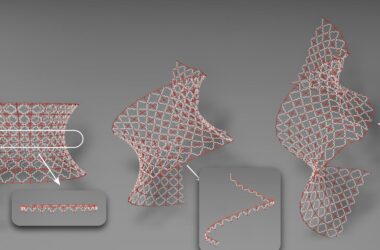
En collaboration avec une équipe de la Federal Reserve Bank of Boston, des experts du MIT ont commencé à concevoir et à tester un cadre technique permettant de mener des recherches sur une monnaie numérique de banque centrale (CBDC) aux États-Unis. Crédit : MIT News, image d’archive
La collaboration avec la Federal Reserve Bank of Boston permet de mieux comprendre comment une monnaie numérique pourrait être développée à l’avenir.
En collaboration avec une équipe de la Federal Reserve Bank of Boston, MIT experts have begun designing and testing technical research through which further examination of a Central Bank Digital Currency (CBDC) can be performed in the U.S.
The effort, known as Project Hamilton, is in an exploratory phase, and the research is not intended as a pilot or for public deployment. Instead, the researchers have explored two different approaches that could be used to process transactions, and thus could indicate the technical feasibility of a potential CBDC model. In a process involving significant design flexibility, the MIT group tested factors such as the volume and speed of transactions, and the resilience of the systems in general, among other requirements for a viable digital currency.
“The core of what we built is a high-speed transaction processor for a centralized digital currency, to demonstrate the throughput, latency, and resilience of a system that could support a payment economy at the scale of the United States,” says Neha Narula, director of MIT’s Digital Currency Initiative and a research scientist at the MIT Media Lab, who led the effort with the Boston Fed. “It is important to note that this project is not a comment on whether or not the U.S. should issue a CBDC — but work like this is vital to help determine the answer to that question. This project serves as a platform for creating and comparing more viable designs, and provides a place to experiment and collaborate on more advanced digital currency functionality.”
The researchers developed two complete sets of computing source code, or “codebases,” for the software systems. One codebase was capable of handling 1.7 million transactions per second, with 99 percent of those transactions finishing in less than a second — well above the basic benchmark of 100,000 transactions per second they sought to achieve. The other codebase was able to process about 170,000 transactions per second. That level of throughput would help finalize every transaction at a central bank, while enabling the growth of other machine-to-machine transactions — both of which would be vital to a potential CBDC.
Those findings have been released in a paper titled, “A High Performance Payment Processing System Designed for Central Bank Digital Currencies,” released by MIT and the Federal Reserve Bank of Boston. The Project Hamilton software, called OpenCBDC, has been released under an MIT open-source license as well. It is one piece of work among others being done on CBDC issues in the Federal Reserve system.
To be sure, any steps toward a digital version of currency would involve many additional policy decisions and software features that would need to be settled by the U.S. Congress and other regulatory experts. As the team points out in the paper’s executive summary, “several technical design questions remain open for investigation. The answers to these questions will have meaningful implications and consequences for what options are, or are not, available for policymakers.”
Indeed, Narula emphasizes, “The policy conversation around central bank digital currency is still in its infancy.” And in relation to that, she adds, “There are many research questions left to answer that we haven’t gotten to yet, such as the roles of intermediaries, how to promote access securely, and how to design for those who might not have smartphones or consistent internet access.”
Still, many countries are displaying interest in the concept of a CBDC: The Central Bank of the Bahamas, the Eastern Caribbean Central Bank, and the Central Bank of Nigeria have already issued CBDCs, and China is running a late-stage CBDC pilot project. The new research is a step toward a robust hypothetical CBDC model, at a scale that could be used by an economy the size of the U.S.
The Project Hamilton research collaboration between MIT and the Boston Fed began in August 2020, as an initiative to examine a hypothetical CBDC model. The work conducted so far represents phase one of the project, an evaluation of the fundamentals of transaction processing.
“We believe that even before the policy discussions begin in earnest, it is important to dive deeply into the technology questions, and this research was designed with that in mind,” says Jim Cunha, executive vice president of the Federal Reserve Bank of Boston. “While policy decisions impact system design, we also believe groundbreaking research can inform policy makers on what is possible.”
A feasible option
In each of the two digital currency designs the MIT and Boston Fed teams tested, users interact with a centrally administered transaction processor, using digital wallets with individual, cryptographic signatures that authorize the movement of funds. One ledger, which keeps a complete record of transactions in the order they were processed, turned out to be the slower of the two systems. “We found that it had pretty significant bottlenecks,” Narula says.
The researchers also note that the faster system, the one processing 1.7 million transactions per second, the transaction quantity “appears to scale linearly with the addition of more servers,” which would sustain an even larger volume of activity.
The team was aware that consumer privacy would likely be an essential consideration in the design of a working U.S. digital currency, and they designed relatively streamlined systems with that issue in mind.
“We created architectures where the central bank didn’t necessarily need to see or store [much] renseignements sur les utilisateurs “, dit Narula, tout en notant qu’en fin de compte, les pratiques de CBDC en matière de protection de la vie privée seraient éclairées par des choix politiques.
La question de la résilience du système est également essentielle pour toute CBDC. Dans ce cas, la modélisation effectuée par les chercheurs du projet Hamilton a montré que si deux grandes régions des États-Unis perdaient leur connectivité, le système de monnaie numérique pourrait continuer à fonctionner ailleurs et ne subirait aucune perte de données ou perturbation du système.
Selon les responsables de la Fed de Boston, ces travaux représentent une étape importante dans l’évaluation du potentiel d’une CBDC.
“Faire des recherches sur une hypothétique CBDC américaine signifie que vous devez penser aux enjeux les plus élevés possibles”, déclare Robert Bench, vice-président adjoint du groupe Paiements sécurisés de la Fed de Boston. “La pression technique exercée sur un futur dollar numérique théorique serait immense. Nous sommes fiers du travail réalisé par notre équipe et le MIT pour construire un moteur de traitement qui offre à la fois les fonctionnalités et la flexibilité nécessaires pour comprendre comment la monnaie pourrait fonctionner dans les décennies à venir.”
La voie à suivre
Comme le souligne Narula, il reste un large éventail de questions sur une CBDC qui devraient être discutées entre les représentants du gouvernement, dans les forums de politique publique et entre les ingénieurs en logiciel, afin de déterminer la viabilité d’une monnaie numérique de banque centrale et si elle pourrait être construite de manière à satisfaire les préoccupations en matière d’accessibilité et d’inclusion.
La recherche technique peut soutenir différentes approches de la CBDC, y compris les modèles de vente directe aux consommateurs, tandis que le gouvernement devra probablement déterminer si les institutions financières joueront également un rôle. Et, comme l’a souligné Narula dans témoignage en juin dernier devant la commission des services financiers de la Chambre des représentants des États-Unis, environ 36 % des personnes aux États-Unis qui n’ont pas de compte bancaire ne possèdent pas non plus de smartphone. Dans ce domaine comme dans d’autres, les décisions politiques et la conception des technologies se chevauchent.
La publication du logiciel du projet Hamilton sous sa licence open-source pourrait aider les gens à collaborer davantage à la recherche sur les CBDC.
“C’est clairement une façon importante de construire, de mettre en œuvre et potentiellement de lancer, en grande partie parce que les systèmes monétaires bénéficient de la transparence et de la vérifiabilité, et le code source ouvert offre ces deux choses “, dit Narula.
Les chercheurs impliqués dans le projet Hamilton poursuivent maintenant une autre phase de leur recherche, dans laquelle ils analyseront d’autres types de fonctionnalités liées à une hypothétique monnaie numérique. Il pourrait s’agir des outils nécessaires à la protection de la vie privée et à la conformité, des questions relatives aux contrats intelligents et à de nombreuses autres utilisations spécifiques, de l’auditabilité, etc.
“Il y a de nombreuses questions de conception importantes qui n’ont pas encore été résolues, et nous sommes impatients de faire plus de recherche pour aborder ces questions “, dit Narula.
Référence : OpenCBDC



